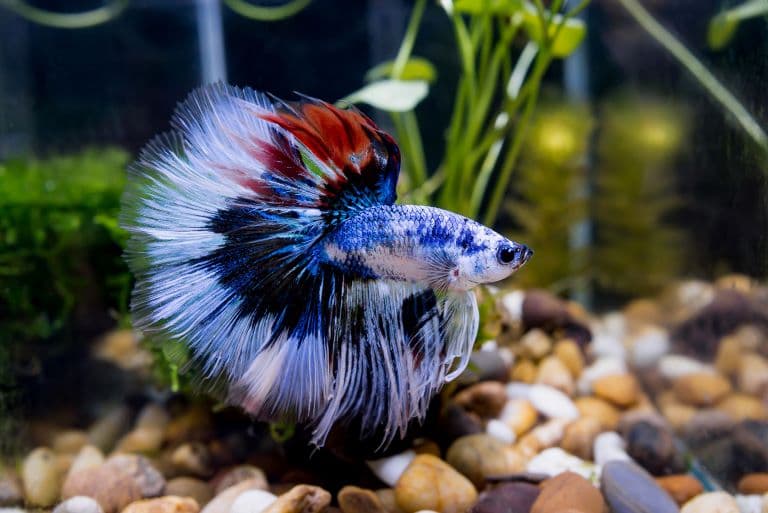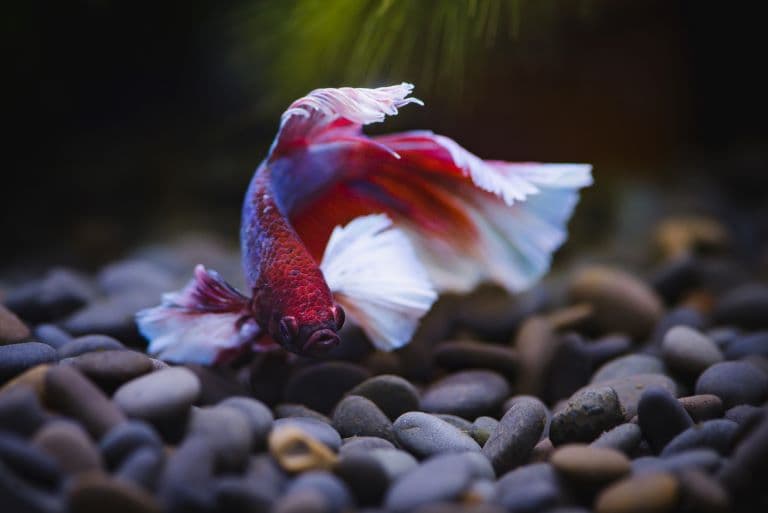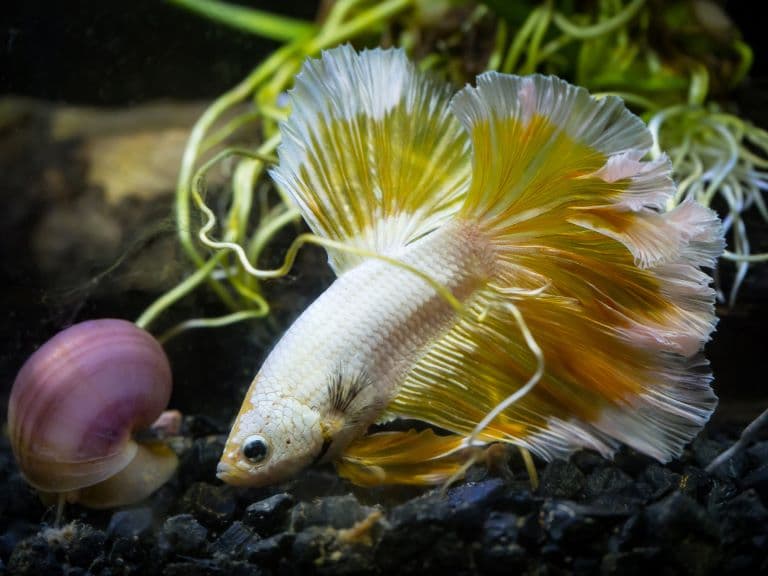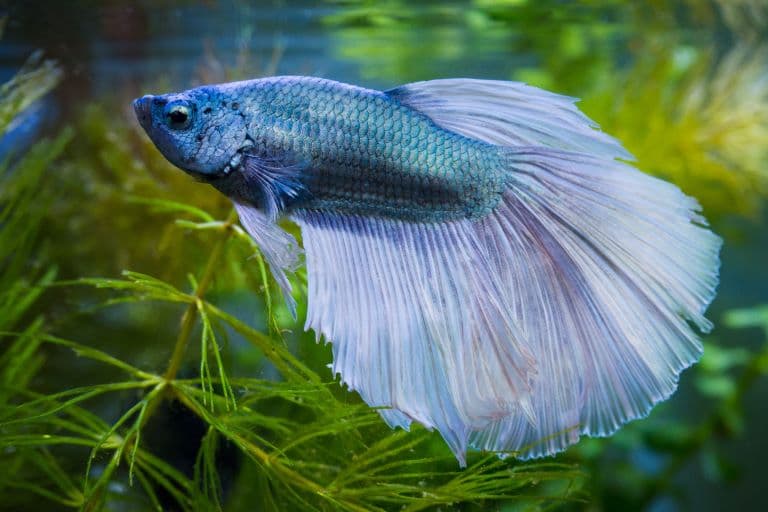Siamese Fighting Fish Profile
In Southeast Asia (and some places in Africa), there are members of a family of fish that can do things most fish can’t. These special little predators have an organ that allows them to survive in otherwise inhospitable conditions.
Among them is a fish prized for its competitive and violent spirit, and known to readily engage in competitions to establish who is the Betta man.

Siamese Fighting Fish Facts Overview
| Habitat: | Marshes, floodplains, rice fields |
| Location: | Southeast Asia, native to Thailand |
| Lifespan: | Up to five years |
| Size: | Around 8cm (3 inches) long |
| Weight: | Up to 9g in giant varieties |
| Colour: | Naturally green, brown or grey, but bred into different colours |
| Diet: | Smaller aquatic animals |
| Predators: | Predatory fish, cats, salamanders, wading birds |
| Top Speed: | Not recorded |
| No. of Species: | 1 |
| Conservation Status: | Vulnerable (IUCN) |
Siamese fighting fish are one of the oldest domesticated fish breeds, but they are still wild varieties in Thailand and the surrounding countries in Southeast Asia.
They’re marshland specialists, living in shallow, hot water where the oxygen is at risk of running out.
But unlike most fish, they have a coping strategy for this which allows them to fiercely defend their territories against competitors.
Interesting Siamese Fighting Fish Facts
1. They’re domesticated fish
Bettas are an entire genus of fish, but in the West, when someone uses the word, it’s more than likely they mean this particular fish.
Betta spelndens has at least 1000 years of domestic breeding behind it and can be found all over the world in aquaria. They were originally bred to fight, having been recognised as tough little SOBs in the wild, and sports emerged akin to aquatic cockfighting, in which individuals would be pitted against one another as a gamble.
Selective breeding has created a wide range of morphs from the wild variety, which is already diverse in itself. They now come with spic, frilly fins and tails, presented in blues, yellows, reds, oranges, pinks and whites, as well as various blends and mixes of all of these.
In the wild, they’re a little humbler, but still pretty little fish. They have much smaller fins and are generally brown or green, elongated with a fanned tail.

2. They’re from low-oxygen environments
In the wild, these fighters occupy warm, shallow waters with a lot of vegetation. They are predatory so enjoy the mosquito larvae, crustaceans and other critters that occupy their swampy environments.
Slow-flowing lakes, paddy fields and other marshy waters are perfect for these fish, even though the heat and decomposition of plant matter often create anoxic conditions.
Where most fish would suffocate, Bettas just breathe the air. 1
3. They can breathe air
Bettas are Anabantiformes. This family of fish are said to have special teeth all the way in the backs of their mouths for processing tough prey items, but another family quirk is the labyrinth organ, a rare and very handy tool found in only a handful of known fish species.
This organ is essentially a bony structure with a high-surface area, lined with respiratory epithelial cells – much like a bony version of the lung. Amazingly, it means that when the gills aren’t able to do their job, this fish can pop its head out of the water and take a big breath of fresh air. 2 3
4. They can go a long time without eating
This species is highly carnivorous, to the point where it doesn’t handle carbs well. But this protein-rich diet keeps it going for a long while without food, and morbidly curious betta owners state that this fish can go two weeks without eating.
They’re especially known to lose their appetite for a couple of days after a big meal, being sated easily on rich, animal protein.

5. They dance
The long fins in the beautiful wild betta have been bred to ridiculous – yet stunning – proportions over the last 1000 years, but even in the wild, they’re a sight to behold, especially if you’re a lady betta.
When such a woman catches the eye of a male, he’ll flare his gills, spread his fins like the fans of a bailaora and put on a show for the lucky audience.
The female’s response is almost as cool. If she likes it, she’ll turn dark and present with some lines down her back that may as well have handy arrows on them.
A successful pairing sees the male make a “bubble nest” which is a cool fishy thing that functions much like the leafhopper’s “cuckoo spit” – it’s a protective mass of mucous and air in which eggs can be laid and hatch safe from predators, following a fishy cuddle called the ‘nuptial embrace’.
This beautiful theatre reaches its crescendo when the female lays her eggs in the bubble nest and is then promptly and aggressively ejected from the male’s territory.
6. They fight
After all, they’re not called Siamese-loving fish. Neglectful keepers of this species will note that if the female isn’t removed from the tank after laying her eggs, she’s likely to be killed.
Bettas are remorseless when it comes to their territorial behaviour, and a one-night stand is plenty for the male. He’ll chase her out before even fertilising the eggs she left being and then will fiercely guard his new clutch against all foes.
One good reason for this shift in attitude is that females are known to eat the eggs they’ve just laid, should they fall from the bubble nest. So, best get her out of there before she causes any damage. 4

7. They bully native fish
It’s hardly any wonder that the Charles Arthur Salvador of the fish world doesn’t play nice with the natives of the waters they’re introduced to.
Their popularity in aquaculture has led to numerous bettas making it through the toilet gauntlet and into local swamps and waterways.
Australia, Brazil, Singapore and various Central American waters are now vulnerable to the tiny menace, and in many of these places, they’ve become invasive. 5
8. Habitat degradation is causing problems
But the wild fish are struggling with their own issues too. Habitat degradation is reducing the number of viable zones this brute can live in, and lots of the traditional farming practices have given way to more intensive ones, especially in Thailand.
It’s an uncertain future for the Siamese fighting fish, and they’re now classed as vulnerable and in decline by the IUCN.
Siamese Fighting Fish Fact-File Summary
Scientific Classification
| Kingdom: | Animalia |
| Phylum: | Chordata |
| Class: | Actinopterygii |
| Order: | Anabantiformes |
| Family: | Osphoremidae |
| Species: | Betta |
| Genus: | Splendens |
Fact Sources & References
- Aqua Diary (2024), “Why Betta Fish Gulp from the Tank Top! Gasping for Air”, YouTube.
- M Tate (2017), “Life in a bubble: the role of the labyrinth organ in determining territory, mating and aggressive behaviours in anabantoids”, National Library of Medicine.
- “Parasphenoid”, Science Direct.
- (2019), “Breeding Betta Fish: Step by Step Guide to Spawning”, leaffin.
- Michael P. Hammer (2019), “Establishment of Siamese Fighting Fish on the Adelaide River floodplain: the first serious invasive fish in the Northern Territory, Australia”, Springer Link.
